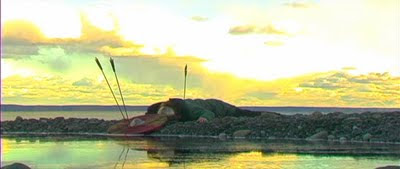Though it played for a week at the Siskel last year, I didn't get around to seeing Severed Ways until recently, so of course now I'm kicking myself, because there are few things I would've loved to have seen first in Theater 2 than this cross between Los Muertos, the last reel of Last of the Mohicans, Rossellinian film-teaching, Denisian sensation and Straub's "nature has ten million times the imagination of the most imaginative artists" maxim. In short, the film Werner Herzog would make if he had any balls. There are a few Herzogs I like, but his P.T. Barnum all-bark-no-bite shtick, while entertaining press conference / interview fodder, can't really hide his paucity of ideas about form (not to be confused with style; the most radical -- and moral -- ideas about form have come largely from directors uninterested in imposing a "personal style" on their films). Tony Stone, on the other hand, is as expressive and imaginative with form as can be, and as likely to cross cine-action and "contemplation" (or whatever the kids are calling it these days) as Takashi Miike. The color of the video images ranges from hyper-saturated second-half-of-In-Praise-of-Love paint to home-movie flatness to Mystery of Oberwald dream monochrome, the sound from field recordings to heavy metal to dubbed-in mono Old Norse, the camerawork (emphasis on the work) from Agnes Godardian handheld to Moonfleet, Jr. tableaux, all in the strangest of formats, MiniDV 'scope.
 Anyway, since this is essentially the story of two badass dudes / close friends traveling around North America in the 11th century, it's interesting that Stone treats this emotional material chiefly through physical sensation, like Howard-Hawks-if-Howard-Hawks-was-Naomi-Kawase (meaning: a little like Michael Mann), and that the "educational" thrust of the narrative (how a tree is chopped down, how a chicken is killed, how Vikings felt about Christianity) is largely there to provide a framework for Stone's very serious playfulness. The Big Sky meets Hallelujah the Hills (big surprise: Stone studied under Adolfas Mekas at Bard). The tragedy of the plot is very Michael Mann, two people on the brink of being obliterated by history: as Volnard (Fiore Tedesco) puts it, their goal isn't to get back, but to get back and have their story "put in stone."
Anyway, since this is essentially the story of two badass dudes / close friends traveling around North America in the 11th century, it's interesting that Stone treats this emotional material chiefly through physical sensation, like Howard-Hawks-if-Howard-Hawks-was-Naomi-Kawase (meaning: a little like Michael Mann), and that the "educational" thrust of the narrative (how a tree is chopped down, how a chicken is killed, how Vikings felt about Christianity) is largely there to provide a framework for Stone's very serious playfulness. The Big Sky meets Hallelujah the Hills (big surprise: Stone studied under Adolfas Mekas at Bard). The tragedy of the plot is very Michael Mann, two people on the brink of being obliterated by history: as Volnard (Fiore Tedesco) puts it, their goal isn't to get back, but to get back and have their story "put in stone." I dig Stone's completely unironic anachronisms (like the long take where the director / screenwriter / editor / co-star headbangs to a song on the soundtrack after chopping down a tree), but what I like even more is a certain approach, very Rohmer in some respects, about trying to portray a past era the way its people perceived it: the movie has some great landscapes, but it's very pre-cartographic and pre-geographic in its thinking, shot mostly in close-ups with an emphasis on the leaves on the ground and the strange animals crawling around over the real lay of the land. Stone's lost Vikings don't have to say that they have no idea where they are; we can see it. And for a movie that's pretty sparse on dialogue, it has a real respect for oral tradition; the most beautiful sequence begins when Volnard starts to tell a story, and his voice dissolves to make way for a dialogueless / narration-less sequence that recounts the story in rough and tactile images, as though we were simultaneously experiencing his memory and what Ord (Stone) imagines.
I dig Stone's completely unironic anachronisms (like the long take where the director / screenwriter / editor / co-star headbangs to a song on the soundtrack after chopping down a tree), but what I like even more is a certain approach, very Rohmer in some respects, about trying to portray a past era the way its people perceived it: the movie has some great landscapes, but it's very pre-cartographic and pre-geographic in its thinking, shot mostly in close-ups with an emphasis on the leaves on the ground and the strange animals crawling around over the real lay of the land. Stone's lost Vikings don't have to say that they have no idea where they are; we can see it. And for a movie that's pretty sparse on dialogue, it has a real respect for oral tradition; the most beautiful sequence begins when Volnard starts to tell a story, and his voice dissolves to make way for a dialogueless / narration-less sequence that recounts the story in rough and tactile images, as though we were simultaneously experiencing his memory and what Ord (Stone) imagines.



2 comments:
yeezy
a bathing ape
supreme clothing
hermes
jordan shoes
supreme clothing
off white
kd 12
supreme clothing
kyrie 7
qiiaoyiiqiajh33sd
golden goose outlet
golden goose outlet
golden goose outlet
golden goose outlet
golden goose outlet
golden goose outlet
golden goose outlet
golden goose outlet
golden goose outlet
golden goose outlet
Post a Comment